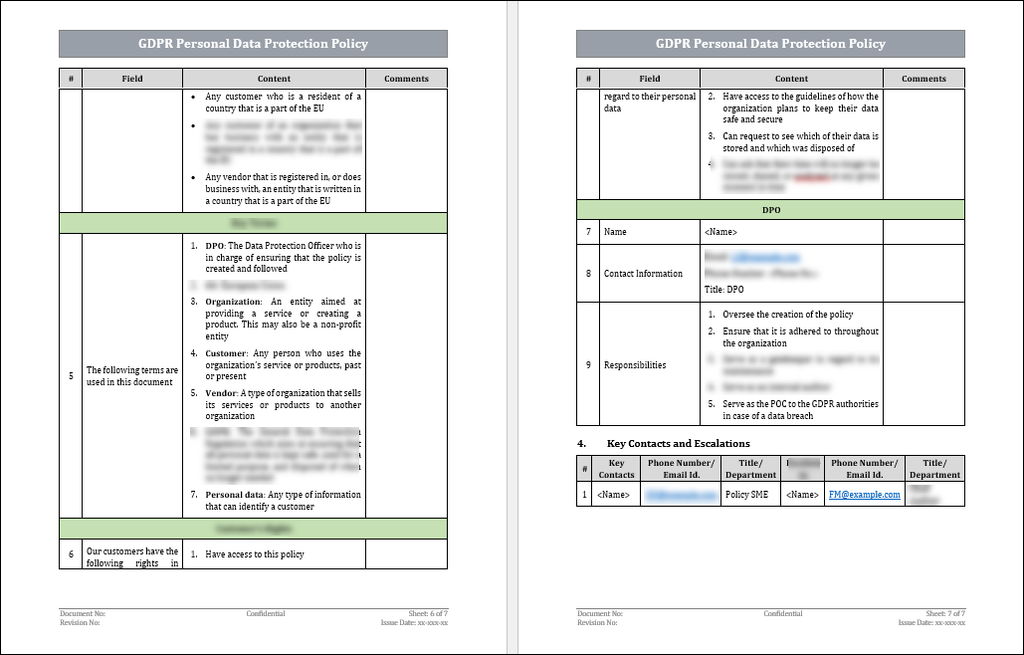GDPR Personal Data Protection Policy Template
Introduction
The GDPR guiding principle is to keep all personal information protected and only use it for a specified goal. For the organization to demonstrate that it is compliant with this guideline, a protection policy is required to be created. This policy is an internal document to be used by the IT department and is aimed at explaining the GDPR statutes and how the organization plans to adhere to them.

The policy should be used by the IT department to ascertain that it is in line with the GDPR guidelines in all aspects pertaining to personal data protection policies. Each field of the policy should be filled in, even if to say that it isn’t in the scope of the document.
Scope and Purpose
Creating a policy is arduous work at the best of times, and adding the GDPR stipulations makes the project that much more difficult. Breaking the work into manageable chunks of work can aid in making sure that all the guidelines are adhered to and bringing the entire project together into a manageable task. Working with a template can lessen the load on the IT employees by giving them a task list of action items. Completing these action items will ensure that the policy aligns with the GDPR requirements.
The policy is intended to cover three goals -
1. Break the GDPR requirements down into manageable chunks of work, and assign each to an owner with clear due dates and success criteria.
2. Clearly explain the statutes to the team. Most of the IT staff aren’t compliance experts, and the GDPR is a new area for most.
3. Prove that the organization is committed to keeping their customers’ personal data safe, for any audits that are done.
Required Fields in the Policy
The policy should include the following fields -
1. The goal of the policy: The compliance requirements and how the organization intends to adhere to them.
2. Principals: Explain the GDPR’s principles for data processing and protection.
3. Scope: Outline which customers are covered by the policy (EU residents, vendors that do business with European entities, etc.)
4. Key terms: Serves as a legend for anyone who reads the policy document.
5. The rights of the customers: Outlines the rights of the organization’s customers regarding their personal data.
6. DPO: present the organization’s DPO and their contact details as well as their overall responsibilities.
The Obligations of the Data Controller
1. Ensure that any personal data that is being stored is kept safe and is disposed of when no longer required. The DPO is responsible for creating and implementing this process.
2. Explains to the customers how their personal data is being stored, what it’s used for and for how long it’s stored.
3. Facilitates in updating the policy and sharing it with employees, customers, and vendors.
4. All data subjects who are residents of a country that is a part of the EU are entitled to be protected according to the policy.
6. Any vendor that is registered in, or does business with, an entity that is registered in a country that is a part of the EU is entitled to be protected according to the policy.

Term Definitions
What is a Data Controller?
An organization or person who determines the use of the collected personal data from the data subjects. The data controller owns the collected personal data, decides in which ways it will be processed and bears the sole responsibility for safekeeping it.
What is personal data?
Any type of unique data which relates to an individual data subject. This can include such information as Name, phone number, Email address, ID number, health records, political opinions, IP address, etc.
What is the processing of personal data?
Any act performed on the collected personal data of all the organizations’ data subjects. This may include such actions as storing the data, analyzing it to extract insights or deleting it once it’s no longer required.
What is a data subject (also known as an end-user)?
Any person who created a unique username on the organization’s website, thus giving them the possibility of using that username to perform certain tasks and use features offered on the website.
Who is the DPO?
The Data Protection Officer is the main stakeholder of the organization for all aspects of GDPR compliance. They are responsible for making sure that the GDPR guidelines are adhered to.
Key Takeaways / Conclusions
1. The DPO is responsible for overseeing the creation of the policy, distributing it throughout the organization and performing periodical internal audits.
2. The policy can also be used in external audits as proof that the data controller is adhering to the GDPR guidelines on the subject.
3. They are also responsible for ensuring that it is adhered to throughout the organization.
4. The policy must be periodically updated to follow the changing laws and guidelines of the GDPR.
5. In case of a data breach, The DPO will serve as the point of contact for the GDPR authorities.


